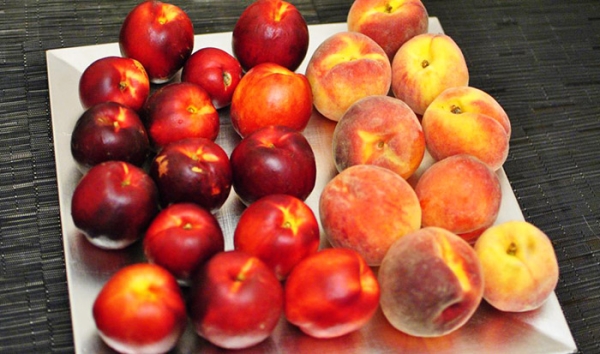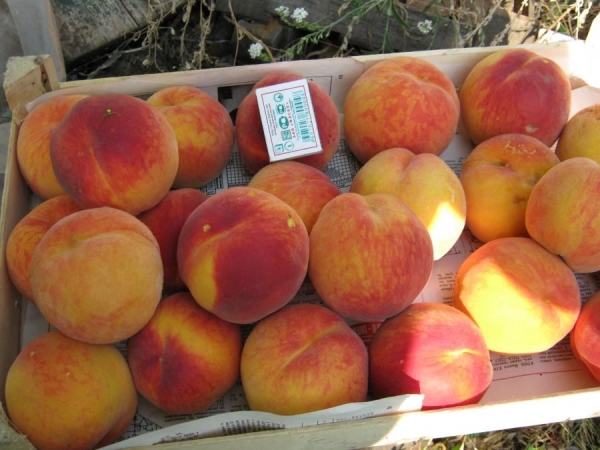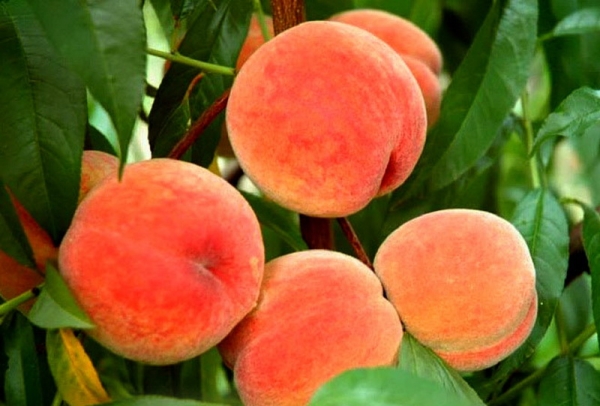Peach - short-lived plant. It is characterized by rapid entry into the phase of fruiting, intensive growth.
Peach buds have the ability to quickly wake up and release young shoots. Crohn grows and if it is not thinned, starting from the second year, the yield will decrease.
From the fourth year peaches will become small and deformed. Young trees begin to bear fruit in the second year after planting. With good care can give a harvest in the first year, during the autumn planting.
But do not allow this to happen. It is better to let the plant grow. Harvest small and the time will be spent, and the plant will lose power.
Table of contents
Juicy peach variety
In the past, gardeners dreamed of peaches, which can be grown in all regions of the country, and not just in the south.
Today, their dreams have come true: breeders have brought out many interesting winter-hardy, frost-resistant varieties with different periods of fruiting, fruit forms and taste.
Peach trees are divided into four groups (depending on the shape of the fruit):
- This peach is a plant with pubescent fruits.
- Nectarine or hollow fruit peach.
- Peach Potanin (Almond Potanin).
- Fergana Peach or figs (flattened fruit).

The ripening time of the fruit, the flowering period - it all depends not only on the area where the tree is grown, but also on the characteristics of the variety:
- Early ripe varieties give the first fruits from July to August.
- Mid-season enter the fruiting stage in early August and delight in the harvest until September.
- Late peaches ripen in autumn: September, early October.
The yield of the plant depends on the correct choice of variety. When buying a seedling, you need to pay attention to several important points, we give their description:
- Where did the sapling come from. If the nursery is in a different lane, then the seedling may die already in the first year after planting, or it will constantly freeze. The variety must be zoned, and the nursery is located in the same climatic zone (preferably even in the same region) where the tree will grow.
- Inspection of graft site. It should be smooth and smooth, without hillocks and frozen juice.
- Plant root system should have a gummy shape. Root in one trunk - no good.
One-year saplings take root better and delight the harvest faster. When buying, it is better to focus on them, but choose strong, healthy plants, and not frail twigs.
Varieties and their description
Ripen early: Kievan Early, White Swan, Grisborough and Redhaven, Morettini
The peculiarity of early ripening varieties is that they quickly enter the phase of fruiting. Two-, three-year-old saplings already produce a small crop. Peak yields in the fourth or fifth year after planting.
Among the representatives of this group, varieties deserve special attention. Kievan Early, White Swan and Redhaven.
The peak yield Redhaven accounts for eleven years. More than one hundred kilograms of fruits are harvested from one tree.

Each variety of early peach in its own good and has a lot of advantages.
Advantages of early peach varieties:
- form a wide crown with a height of not more than 5 meters;
- plants bloom in April;
- enter the phase of fruiting quickly: in the fourth year after planting the seedling;
- fruiting stretched from July to August;
- characterized by high yield, fragrant and tasty fruits.
The first fruits appear on an adult, well-formed tree. This can not affect the yield: with a six-year tree, with proper care, you can collect up to 60 kilograms of peaches.
Another bright representative of this group - Griesborough variety. It is distinguished by an average power of growth, but, unlike the above-mentioned varieties, it has an average winter hardiness.
High winter hardiness peach morettini. One of its advantages is the spreading crown, which is easily shaped.
Morettini fruits ripen one of the first, but have an average transportability. It does not allow to transport fruit over long distances.
Mid-term ripening: Collins, Cardinal, Golden Moscow, Siberian, Saturn, Kremlin, Don
Varieties of medium ripening allow the peach conveyor to continue.
The peculiarity of plants of this species:
- high, sprawling crown (from 5 meters);
- high yield;
- good winter hardiness;
- large fruits.
Mid-season peaches have a huge number of varieties, but among them there are several species that ideally show themselves in any conditions and do not require special care: Collins, Cardinal, Golden Moscow, Siberian, Saturn, Kremlin.
Grade Cardinal famous for its huge fruits (from 140 g) and excellent taste. This is one of the most delicious peach species. On the international tasting scale, he received five points. This is the highest rating.
The plant is resistant to diseases, but it is difficult to tolerate recurrent frosts. It is better to plant it on a windless place, not far from the wall of the house or the fence, but far from water.

Kremlin peach adapts without any problems to the change of temperature, has a high winter hardiness. Because of this, he attracted the attention of gardeners from regions where the summer is cool. With good care the fruits reach 200 g.
Golden Moscow variety recently appeared on the market, but its seedlings are very popular. The plant winters well and is resistant to diseases, has juicy large fruits.
The fruiting period is stretched for almost three weeks. Peach blooms late, after the threat of frost return, and this increases the number of high-quality fruits.
Sort Siberian Farmed by farmers for their excellent transportability. Yellow fruits can be stored in a cold room for up to three weeks. In addition, they are tasty and juicy, and the bone is easily separated from the pulp.
The first crop is harvested in August, and the last fruits are removed in early September.
Peach Saturn stored no longer than 12 days. This is also a lot. The plant has a high winter hardiness (up to -27). Vigorous crown complicates care and this affects the yield.
If you tilt the branches down, you can get a great harvest every year.
The most winter hardy representative of this group is Donskoy peach. It not only withstands severe frosts, but also quickly recovers after freezing.
Most varieties have juicy pulp and pleasant aroma.. High crown can be regarded as a disadvantage, but with the correct formation of the tree, it is easily eliminated and turns into dignity.
Late, frost-resistant: Fury, Frost, Veteran
A peach was planted, but it does not bear fruit, it only intensively increases the crown? Do not be upset: it is better to be patient and wait a little longer.
Late-ripening varieties of fruit from 5 years after planting the seedling. They are intended for cultivation in the southern regions. In the North and in the Middle Band, they do not have time to mature and turn out to be acidic.
American Fury can withstand temperatures down to -28 degrees. It is appreciated for the huge, up to 300 g orange-colored fruits. The plant is undemanding to care.
Fruit picking falls on September, when only apples and pears remained in the garden. Fruits are stored no longer than six days.
Variety Frost also bred by American breeders who emphasized the winter hardiness and large-capacity plants.
The tree gives a high stable yield, can withstand temperatures down to -26 degrees, resistant to diseases. Fruits are used for fresh food. Stored for ten days.

Sort Veteran differs from late ripening varieties in that it quickly enters the phase of fruiting and has a low growth. The size of the fruit is also not impressive (not more than 150 g).
They love him for good taste. It is ideal for conservation.
Self-pollinated, self-fertile peaches: Inca, Volcano, Harnas, Golden Jubilee
Self-pollinated varieties are very popular with gardeners. To enhance fruiting, recommend planting several plants for cross-pollination. But one tree will also bear fruit.
Among self-pollinated, self-fertile varieties, a good harvest in a single planting gives Inca, Volcano, Harnas, Golden Jubilee.
Harnas belongs to the winter-hardy, early-ripening dessert varieties. This is a strong-growing tree that regularly bears fruit. Its peculiarity is that fruits cling tightly to branches and do not fall off.
Early ripening varieties are characterized by high winter hardiness of trees and flower buds. They withstand recurring frosts. This makes it possible to grow them not only in southern latitudes, but also in the middle belt, as well as in Siberia and the Urals.

In the regions of Siberia, it is necessary to protect the trees from returning frosts.
Mid-season varieties build up a decent crown and then delight the rich harvest.Their disadvantage is that it is difficult to form branches, but a regular and generous harvest allows you to turn a blind eye to it.
The branches of mid-season varieties often bend downward, which facilitates harvesting.
The lack of late ripening varietiesthat they can only grow in a certain area. But if the climatic conditions allow, then these trees will not only decorate the garden, but also delight with tasty fruits.
Plants respond favorably to fertilizing and watering.. Water plays an important role in the formation of fruits. Not only the size of peaches, but also their taste and aroma depend on its quantity.
Give your saplings a little attention and care so that they can turn into beautiful trees and make crops happy every year.

Good day! In Baku, how to purchase Fergana peach seedlings (fig or flat) Can a full-grown tree be grown from seed?